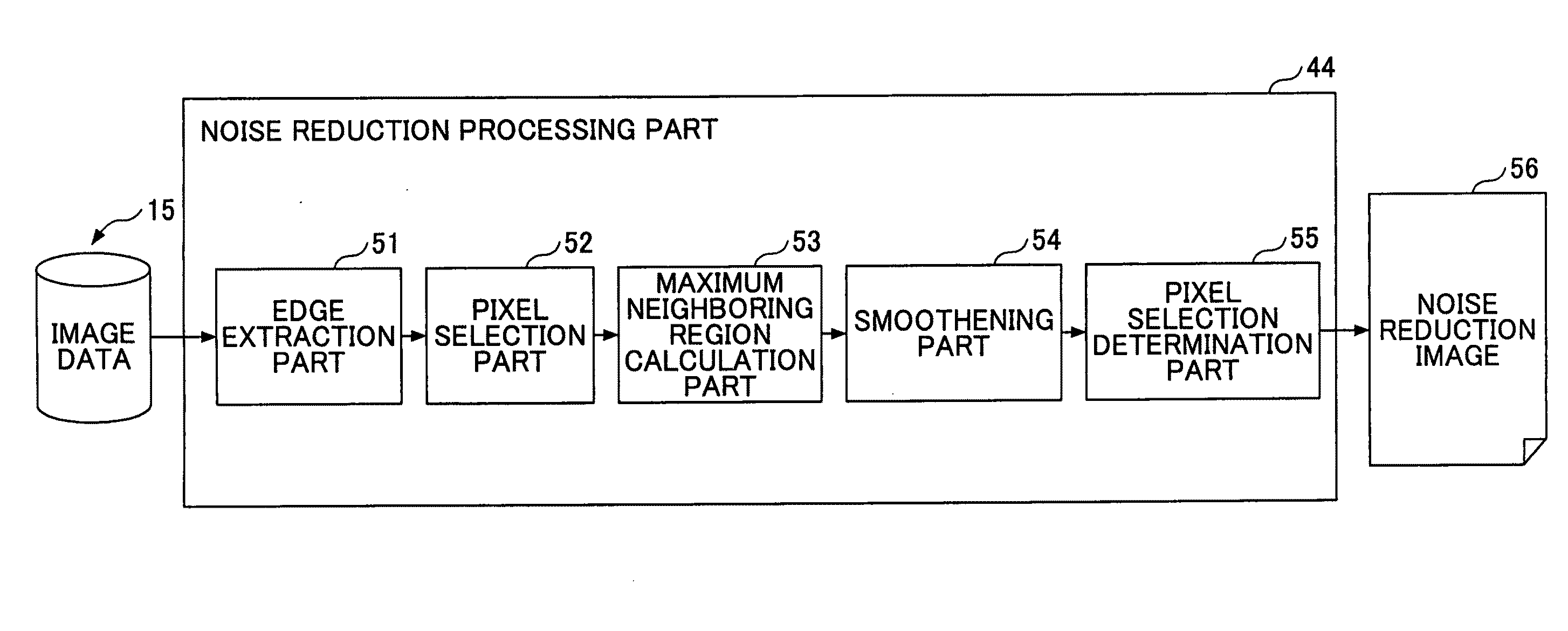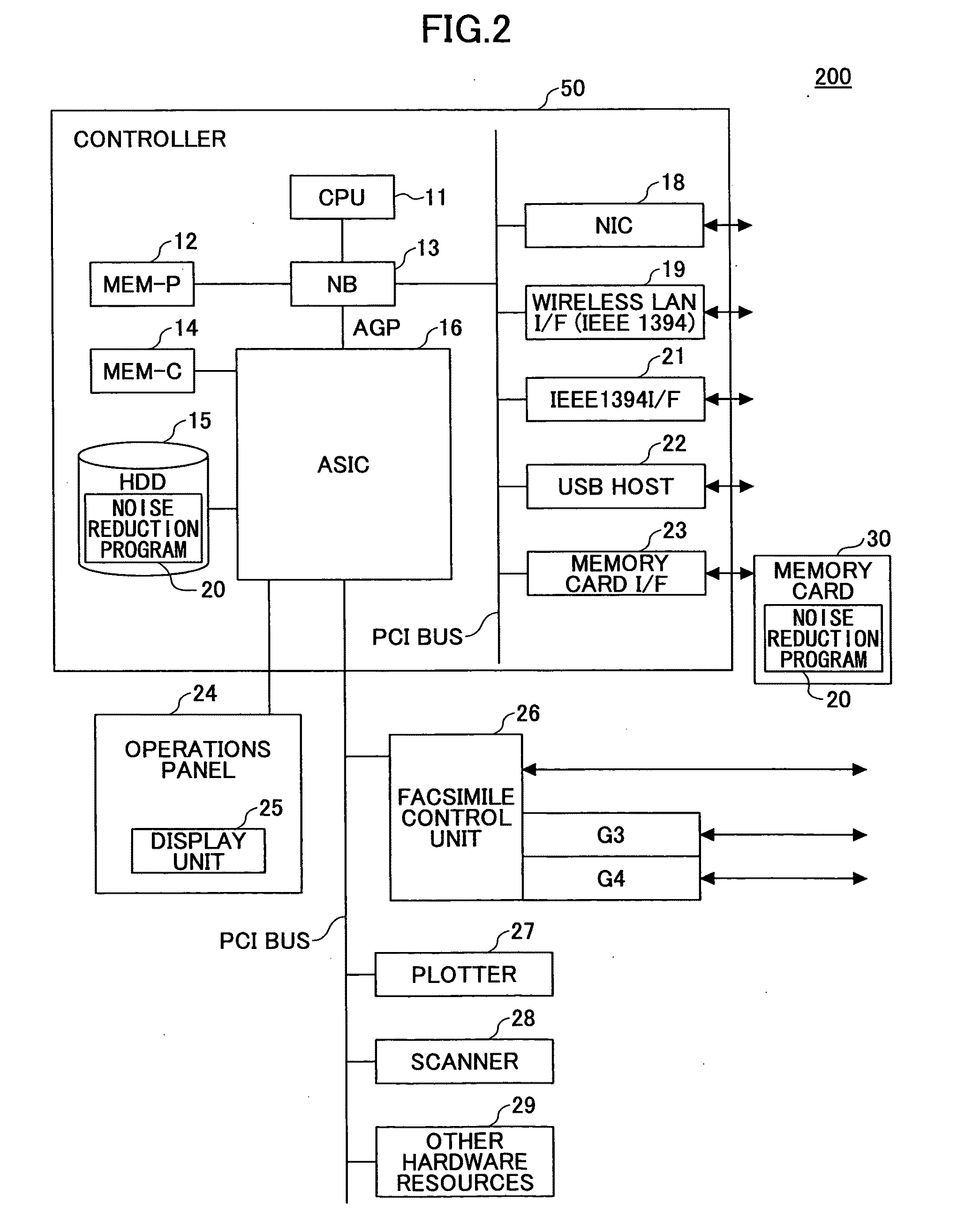Image processing unit, noise reduction method, program and storage medium
a noise reduction and image processing technology, applied in image enhancement, color signal processing circuits, instruments, etc., can solve the problems of inability to perform appropriate noise reduction suitable for neighboring edge structures (pixel value arrangement), image data picked up by image pick-up equipment such as scanners and digital cameras contain noise, etc., to achieve robust noise reduction results
- Summary
- Abstract
- Description
- Claims
- Application Information
AI Technical Summary
Benefits of technology
Problems solved by technology
Method used
Image
Examples
first embodiment
[0061]This embodiment refers to the image processing unit 100 that searches for a neighboring region with a notice pixel as a center so as to form a rectangular shape and represents the area of a maximum neighboring region, where the sum of obtained edge intensities exceeds a threshold, on the variance parameter of a Gaussian filter to perform smoothening processing.
[0062]The neighboring region is composed of one or more neighboring pixel regions including the notice pixel and is formed into a rectangle in this embodiment. Furthermore, the maximum neighboring region is a neighboring region where the sum of edge intensities exceeds a threshold. Therefore, if the edge intensity of the notice pixel is greatly changed, one pixel could form the maximum neighboring region at minimum. On the other hand, if the edge intensities of neighboring regions of the notice pixel are small, the maximum neighboring region becomes large.
[0063]FIG. 4 is an example of a functional block diagram of the no...
second embodiment
[0090]In the first embodiment, n is increased in increments of two so as to find the maximum neighboring region. However, according to this method, the smoothening intensity may not be finely adjusted in some cases because the size of the neighboring region is discretely changed. In view of this problem, this embodiment refers to the image processing unit 100 that can specifically calculate the size of the maximum neighboring region by using an interpolating method.
[0091]Note that similar to the first embodiment, this embodiment uses the functional block diagram of the noise reduction processing part 44 shown in FIG. 4 and the flowchart shown in FIG. 5. This embodiment is characterized by step S104 in the flowchart.
[0092](S104)
[0093]The maximum neighboring region calculation part 53 finds the sum of the edge intensities E in the rectangle of “n×n” pixel regions with the notice pixel as a center. Similar to the first embodiment, the maximum neighboring region calculation part 53 star...
third embodiment
[0101]In the first and second embodiments, the maximum neighboring region is determined based on only the edge intensities E, and the size of the maximum neighboring region is used in the variance parameter of the Gaussian filter. This embodiment refers to the image processing unit 100 that can include the direction of the edges on the Gaussian filter.
[0102]Note that similar to the first embodiment, this embodiment uses the functional block diagram of the noise reduction processing part 44 shown in FIG. 4 and the flowchart shown in FIG. 5. This embodiment is characterized by the smoothening processing in step S105 in the flowchart.
[0103](S105)
[0104]The direction of the edges (hereinafter referred to as an edge direction θ) is set based on, for example, a horizontal direction (zero degrees) as a reference. In this case, the edge direction θ of the edges successively arranged in a vertical direction is set at 90 degrees, and the edge direction θ of the edges successively arranged in t...
PUM
 Login to View More
Login to View More Abstract
Description
Claims
Application Information
 Login to View More
Login to View More - R&D
- Intellectual Property
- Life Sciences
- Materials
- Tech Scout
- Unparalleled Data Quality
- Higher Quality Content
- 60% Fewer Hallucinations
Browse by: Latest US Patents, China's latest patents, Technical Efficacy Thesaurus, Application Domain, Technology Topic, Popular Technical Reports.
© 2025 PatSnap. All rights reserved.Legal|Privacy policy|Modern Slavery Act Transparency Statement|Sitemap|About US| Contact US: help@patsnap.com



